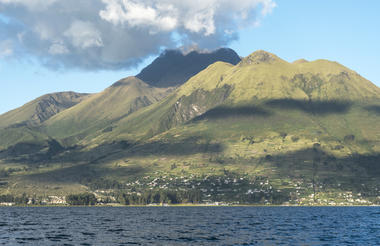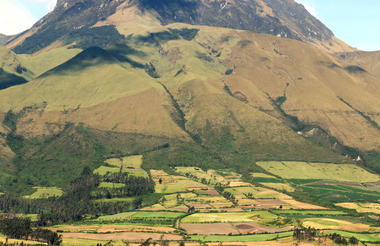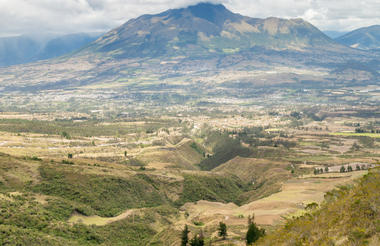Neighbouring Colombia and Peru, Ecuador is a relatively small country that nevertheless offers an enticing array of scenic landscapes, diverse wildlife species and interesting cities. Dense Amazon rainforest, towering Andean mountain peaks, palm-fringed Pacific Coast beaches and fascinating historical sites are all part and parcel of Ecuador’s prolific charms. The former Inca town of Cuenca is the nation’s third-largest city and a Unesco World Heritage Site. This alluring city, with its cobbled streets, beautiful architecture and photogenic plazas, boasts a huge variety of museums and art galleries. The vibrant capital city of Quito is also worth a visit. Arguably the most dazzling jewel in Ecuador’s crown is the Galapagos Archipelago in the Pacific, about 1000 kilometres west of the mainland. Their magnificent, pristine landscapes and prolific wildlife, which inspired Charles Darwin, have made this cluster of islands a world-famous travel destination.
Quito, the capital of Ecuador, lies on the slopes of the Andes’ mighty Pichincha volcano in the Guayllabamba river basin. The city’s Old Town is its main attraction - one of the most well preserved in Latin America and the first-ever UNESCO heritage site. Wander among ancient, colourful streets; pop into glorious historic churches; or spend an afternoon browsing the vibrant Mercado (markets) and learning about the unique, traditional Ecuadorian Sierra culture. Other bucket list items in Quito include a visit to the impressive Casa Museo Guayasamín; the Museo de la Presidencia which provides insight into Ecuador’s history; and a climb up the iconic towers of the Basilica. Numerous gorgeous public parks and a thriving and exciting culinary scene complete the package.
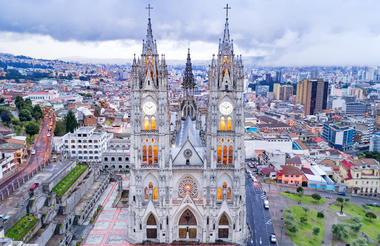
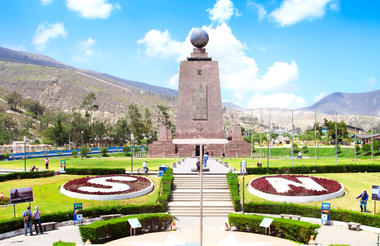
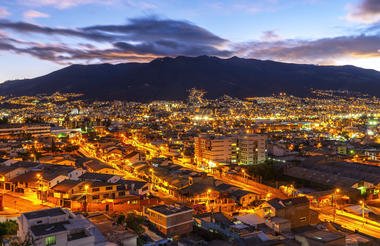
Despite its small size, North Seymour Island, in the Galapagos archipelago, is undoubtedly worth a visit for its astonishing abundance of wildlife. Visitors to the island are typically treated to the sight of sea lions riding waves all the way into shore, marine iguanas basking in the sun, and flocks of pelicans and swallow-tailed gulls feeding just off the coast. The island is also renowned as a natural haven for one of the most sought-after residents in the Galapagos Islands, the Blue-Footed Boobie. During mating season, the island is an ideal place to witness the intriguing mating rituals for which these birds are famous. With its extraordinary profusion of wildlife and close proximity to Santa Cruz, North Seymour Island makes an ideal destination for an adventurous day tour.



Resting approximately 12 kilometres southeast of Santa Cruz, the relatively small island of Santa Fe is one of the oldest islands in the Galapagos archipelago with rock formations below the water’s surface dating back almost four million years. The island is best known for its endemic Barrington Land Iguana as well as its towering prickly pear cacti which have been known to reach remarkable heights of up to 20 feet. The magnificent Barrington Bay is the only visitor site on the island. There are two hiking trails that start here. One leads to a scenic viewpoint atop a cliff and the other wends through a forest of gigantic opuntia cacti. The beach is popular with sea lions and is an excellent spot from which to snorkel the radiant blue-green waters. You may even spot a Galapagos green turtle gracefully swimming by.



San Cristóbal is the easternmost island in the Galapagos archipelago as well as the most populated. Famous for its natural attractions, the island also boasts some wonderful shopping and dining opportunities as well as a local airport. Take a break from snorkeling and hiking to enjoy the best Ecuadorian cuisine, or admire some of the exquisite artwork and designs at local galleries and markets. Must-see attractions include the Galapaguera Tortoise Reserve; the Interpretation Center (which provides important background information on the Galapagos); and Puerto Grande, a protected cove on the north-western side of the island boasting a magnificent white sandy beach - ideal for a peaceful walk, swim or photography sesssion.



Floreana Island is located in the far southern portion of the Galapagos archipelago. As the first of the islands to support permanent human habitation, Floreana boasts a rich heritage complete with tales of buccaneers, pirates, whalers, convicts, and colonists. Visitors are invited to follow in the footsteps of whalers in the 1700s and drop a postcard into the famous "post office" barrel. At the island's northern tip is Punta Cormorant, with its two beaches, one of which forms a nesting site for Galapagos green turtles and is aptly named "Flour Beach" for its soft, powder-white sand. Between these two beaches lies a salt lagoon frequented by long-legged greater flamingoes and other shorebirds. Floreana's unique human history, fascinating geology, remarkable wildlife, and the little village of Puerto Velasco Ibarra, offering excellent lodging and food, make an ideal base for visitors looking to explore these unforgettable islands.



Resting in the western part of the Galapagos archipelago, Isabela Island is larger than all of the rest of the islands combined. Comprising six volcanoes, the island is about 120 km long and covers 4,585 square kilometres. Travellers who make the effort to this visit this remote location will be richly rewarded with a profusion of fascinating wildlife including large numbers of flamingos, typically spotted at the lagoon in town or along the boardwalk to the impressive Giant Tortoise Breeding Center. Don’t miss Concha de Perla, a natural pool which is ideal for snorkelling and interacting with sea lions; Las Tintoreras, a lagoon where white tip sharks come to rest; and Los Tuneles, where you'll find an abundance of turtles, rays, and fish swimming in the canals and pools.
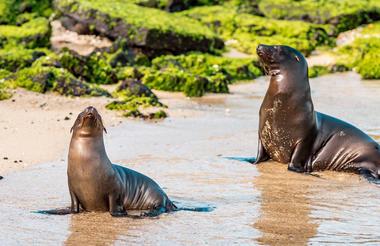
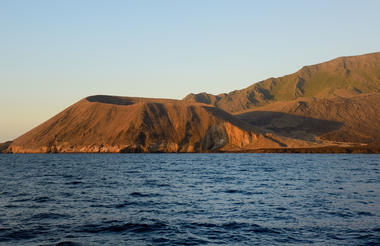
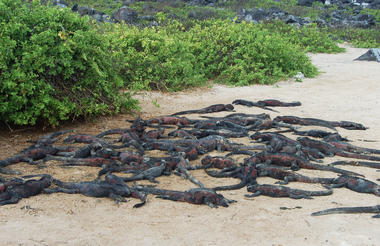
Perched high up in the spectacularly scenic Andes Mountain Range, the small town of Papallacta is known for its breathtaking setting and high-altitude hot springs. The undeniable highlights of this town are tucked away in the surrounding landscape. They include the beautiful Cayambe-Coca Ecological Reserve, boasting numerous glistening lakes and scenic trails and the luxurious therapeutic hot springs at the Termas de Papallacta Spa and Resort, which offer over three-dozen sparkling pools. Nature lovers and adventure seekers alike can discover the beautiful surrounding valleys, explore the lush jungle trails, and soak in the steaming open-air baths with the majestic Andean mountains as a backdrop.



Situated in the northwest corner of the Metropolitan District of Quito, the Mashpi Biodiversity Reserve is a unique and magnificent destination. Spread over 1,300-hectares of untouched wilderness, it harbours both cloud forest and rainforest, and forms part of the globally-important Choco biodiversity ‘hot spot’. Mashpi is home to pumas, kinkajous, hundreds of amphibian and reptile species, thousands of insect and arachnid species, and over 500 species of bird. Visitors can spend days exploring, spotting a vast variety of fauna and flora, and immersing themselves in the biodiverse ecosystems of the reserve. Don't miss the two-kilometre-long aerial tram gliding visitors through and over the rainforest canopy.



The picturesque Ecuadorian rural town of Angochagua sits in the eastern foothills of the mighty Cerro Imbabura, within the magnificent Protected Zuleta Forest Reserve and surrounded by the Andes Mountain Range. This is a nature lover’s ultimate destination. Nearby, there are thick woodlands, extreme mountains, dormant volcanoes and an abundance of unique flora and fauna. Bathe in freshwater springs that spurt along the canyons, hike along craggy peaks, and watch the majestic endangered Andean Condors in flight. Highlights include the Condor Rehabilitation and Interpretation Center, an impressive 11th-century archaeological site, and the chance to learn more about local culture by meeting the neighbouring Indian communities.
